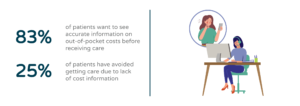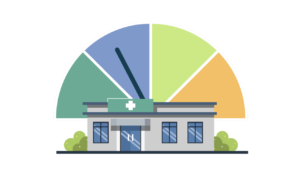3 Reasons Good Faith Estimates Make Smart Business
Rivet Health Guest Blog | March 1, 2023
In this post, you’ll learn how compliance with the federal Good Faith Estimate legislation can increase revenue and prevent unwanted expenditures.
1. Compliance keeps your practice from spending more than you earn.
The Good Faith Estimate (GFE) is part of the No Surprises Act (NSA), which is federal legislation designed to protect patients from surprise medical bills. The Department of Health and Human Services (HHS) with other federal departments created the GFE to specifically protect self-pay and uninsured patients from receiving bills that are substantially more than expected.
The GFE is an estimate of the cost to obtain healthcare without using any type of health plan. The legislation requires virtually all healthcare facilities and providers to 1) notify self-pay patients of their right to obtain a GFE of anticipated charges, and 2) provide a GFE of charges to the self-pay patient before items or services are rendered.

There are many requirements associated with the GFE, such as how quickly a GFE needs to be provided and what information is necessary to have on the GFE. The actual bill for services rendered must not exceed $400 more than the estimated cost given in the Good Faith Estimate.
Failure to comply with any of these requirements may result in patient-provider dispute resolution. In cases of dispute, you will be asked to provide evidentiary support that your team is in complete compliance with federal requirements. If you are not in compliance, you will need to pay for dispute resolution expenses and you may not be paid for services rendered.
A simple, easy-to-use estimation tool can keep you compliant without the hassle of constant watch over the ever-changing requirements of the No Surprises Act.
To learn more about the GFE, see CMS guidelines.
2. Cost transparency provides a better rapport with patients.
Most patients (83%) want to see accurate information on out-of-pocket costs before having health care services, and surprisingly, 25% of patients have avoided obtaining care due to lack of cost information, according to the 2021 Annual Consumer Sentiment Benchmark.

The American Journal of Roentgenology found that “some physicians worry that if they disclose prices, patients will focus preferentially on price (instead of quality) and turn into price shoppers.”
However, research found that “most patients do not regard communications about price as an avenue for reducing health care spending.” For example, take a study of patients requiring elective plastic surgery. Patients who were aware of prices were 41% more likely to schedule a procedure than patients who were unaware of prices.
With a high-powered estimations tool, you can instantly provide on-the-spot estimates for common procedures and services, handle tough payment conversations with confidence and easily train staff to do the same.
3. Prepayment decreases Accounts Receivable (A/R) days & adds revenue.
Within the first 90 days that your balances are in accounts receivable, the collectability of accounts is 90%. Once accounts reach 90 days overdue, the chance of collecting payment drops to 50%. At 180 days, the chance of collecting falls to 20%. Account balances that are over a year old have about a 0% chance of collection.

Even for insured patient balances, slow payment (payment after service) of high-deductible plan patients is the top collection challenge for practices, especially in the first quarter of the year when approximately 40–60% of healthcare bills can be attributed to patient responsibility.
Furthermore, a third of hospital bills fall on patient responsibility and hospitals have historically failed to collect 65 cents for every patient dollar billed.
Up-front account balance payment can reduce, or even eliminate, days in accounts receivable for many of your services and procedures. You can confidently collect partial or full payment from all of your patients with an accurate estimation tool that tracks deductible spent, multiplayer and multi-treatment complexities and insurance verification. Combine your estimations solution with a patient-led registration platform that will ask for payment of past due balances, co-pays and patient estimations at check in. Accelerate collections by ensuring that each time a patient checks in they will know their responsibility (including estimates) and will be prompted to pay.
Choose integrated solutions that will put revenue back into your practice. See how you can use Rivet Health’s estimations technology, seamlessly with Clearwave Core’s instant eligibility verification and patient-led registration to make it happen. Stay compliant and increase patient collections – get started!
What is Rivet?
Rivet Health is the leading healthcare A/R acceleration platform for hundreds of practices and hospitals across the United States. Rivet delivers provider growth by powering the empowerment of healthcare through incomparable technology. Rivet integrates seamlessly with Clearwave to drive scalable revenue expansion through accurate, No Surprises Act-compliant, multi-language patient cost estimates, financial transparency driven by real-time automated insurance verification and up-front payment capabilities. Learn more about how Rivet can accelerate your A/R.
Recommended for you
Related Posts
Calculate How Medical Insurance Verification Software Saves 500+ Staff Hours
Reading Time: 3 minutesBy Blakely Roth | April 16, 2025 Stretched thin in the billing or administrative department and looking for a way…
Top 2 Trends Impacting Orthopedic Practices & Patients in 2025
Reading Time: 5 minutesBy Chloe From Clearwave | February 20, 2025 In 2025, orthopedic practices face the dual challenge of integrating high-cost technologies…
3 Easy Steps to Increase Upfront Point-of-Service Collections in Healthcare
Reading Time: 5 minutesBy Chloe From Clearwave | January 6, 2025 While many healthcare practices struggle with declining Medicare payments and rising costs,…




